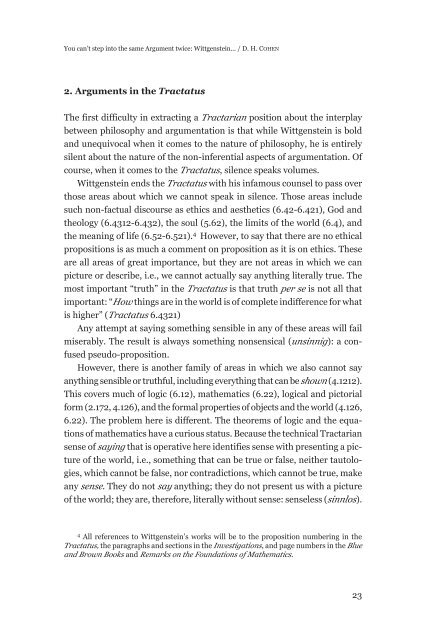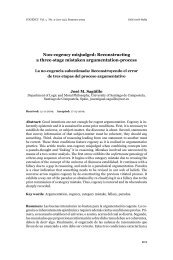Cogency v2 n2
Cogency v2 n2
Cogency v2 n2
You also want an ePaper? Increase the reach of your titles
YUMPU automatically turns print PDFs into web optimized ePapers that Google loves.
You can’t step into the same Argument twice: Wittgenstein... / D. H. COHEN<br />
2. Arguments in the Tractatus<br />
The first difficulty in extracting a Tractarian position about the interplay<br />
between philosophy and argumentation is that while Wittgenstein is bold<br />
and unequivocal when it comes to the nature of philosophy, he is entirely<br />
silent about the nature of the non-inferential aspects of argumentation. Of<br />
course, when it comes to the Tractatus, silence speaks volumes.<br />
Wittgenstein ends the Tractatus with his infamous counsel to pass over<br />
those areas about which we cannot speak in silence. Those areas include<br />
such non-factual discourse as ethics and aesthetics (6.42-6.421), God and<br />
theology (6.4312-6.432), the soul (5.62), the limits of the world (6.4), and<br />
the meaning of life (6.52-6.521). 4 However, to say that there are no ethical<br />
propositions is as much a comment on proposition as it is on ethics. These<br />
are all areas of great importance, but they are not areas in which we can<br />
picture or describe, i.e., we cannot actually say anything literally true. The<br />
most important “truth” in the Tractatus is that truth per se is not all that<br />
important: “How things are in the world is of complete indifference for what<br />
is higher” (Tractatus 6.4321)<br />
Any attempt at saying something sensible in any of these areas will fail<br />
miserably. The result is always something nonsensical (unsinnig): a confused<br />
pseudo-proposition.<br />
However, there is another family of areas in which we also cannot say<br />
anything sensible or truthful, including everything that can be shown (4.1212).<br />
This covers much of logic (6.12), mathematics (6.22), logical and pictorial<br />
form (2.172, 4.126), and the formal properties of objects and the world (4.126,<br />
6.22). The problem here is different. The theorems of logic and the equations<br />
of mathematics have a curious status. Because the technical Tractarian<br />
sense of saying that is operative here identifies sense with presenting a picture<br />
of the world, i.e., something that can be true or false, neither tautologies,<br />
which cannot be false, nor contradictions, which cannot be true, make<br />
any sense. They do not say anything; they do not present us with a picture<br />
of the world; they are, therefore, literally without sense: senseless (sinnlos).<br />
4<br />
All references to Wittgenstein’s works will be to the proposition numbering in the<br />
Tractatus, the paragraphs and sections in the Investigations, and page numbers in the Blue<br />
and Brown Books and Remarks on the Foundations of Mathematics.<br />
23








